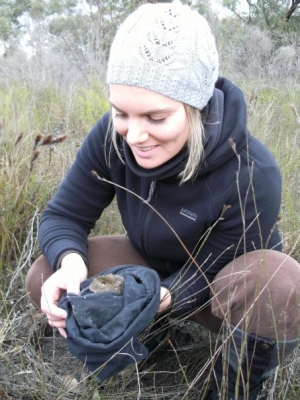Major Birds Australia prize to Christine Connelly
Research news
Christine Connelly, a PhD student in the School of Life and Environmental Sciences, has won a major 2011 Birds Australia grant, the prestigious Professor Allen Keast Research Award.
Christine is the second Deakin researcher in successive years to win the $5000 award, which last year went to another PhD student, Kate Stevens.
The exclusive Professor Allen Keast Research Award goes to the top ranked applicant in the annual Birds Australia grants round.
Christine’s initial application was for the Stuart Leslie Bird Research Award.
The Professor Allan Keast Award is made possible through the generosity of the late Allen Keast, Emeritus Professor of Biology at Queens University, Kingston Ontario, Canada.
Professor Keast arguably remains Australia's most influential ornithologist given the scope of his research, the number of scientists with whom he worked, and the part he played in educating the global ornithological community about Australia's birds.
His desire to fund a postgraduate award stems from a lifelong passion to encourage and support young ornithologists.
Christine’s project is titled: Coping in the big city: Investigating the effects of urbanisation on eastern yellow robin populations in Melbourne, Victoria.
“The primary aim of this study is to explore the effects of urbanisation on eastern yellow robin populations by examining the reasons for which this species is not presently found in highly urbanized areas,” she said.
“I will test four hypotheses that may explain this absence, specifically, whether eastern yellow robin success in urban areas is limited by patch area and quality, resource availability, dispersal, and/or predation.”
Urbanisation is recognised as a key threat to biodiversity,however, the effects of urbanisation on native fauna in Australia are poorly understood. There is a need for studies that investigate the responses of individual species to urbanization.
The eastern yellow robin is an ideal model species for investigating urbanisation because it is widely distributed and locally abundant, occurring in urbanised areas, but is known to decline in response to urban disturbance.
This project will be conducted under the supervision of Dr John White, Dr Raylene Cooke (who also supervises Kate Stevens) and Dr Mike Weston, over three years from February 2011 to February 2014.
The proposed methods incorporate a range of research techniques in order to maximise data collection efficacy and to effectively contribute to conservation outcomes and improve the understanding of the effects of urbanisation on wildlife.
Christine completed her undergraduate degree in 2005, then worked in the environment industry for five years, including in policy and legislation development with the Department of Sustainability and Environment and in private consulting with Practical Ecology.
She has also volunteered on a number of fauna monitoring projects, including as a Team Leader with the Victorian National Parks Association’s Nature Watch program.
“I have also had a long interest in birds and have enjoyed birdwatching at many locations in Australia," she said.
Christine is an active member of Birds Australia, the Victorian Waders Study Group and the Australian Bird Study Association.
Kate Stevens’ research focuses on the behaviour and ecology of the Grey-crowned Babbler Pomatostomus temporalis.
The Grey-Crowned Babbler (GCB) is listed as endangered within Victoria and numerous knowledge gaps persist. To aid the survival of GCBs, further ecological and biological studies will ensure that the best available conservation information is made available for management strategies.
In Victoria the GCB is largely persisting within decreasing areas of roadside vegetation. Coupled with this, Babblers are habitat specialists and under increasing pressure from the effects of fragmentation on their highly social and cooperative breeding nature.
This study is focused on specific aspects of GCB ecology that are currently poorly understood. A comparative habitat-use analysis, incorporating different vegetation types across an environmental gradient, will determine critical habitat resources across the southern part of their range.
Determining fragmentation and isolation thresholds will help identify populations under greatest risk of extinction, and an understanding of brood-nest site-selection patterns will highlight areas of reproductive processes which may be better managed.
Share this story

